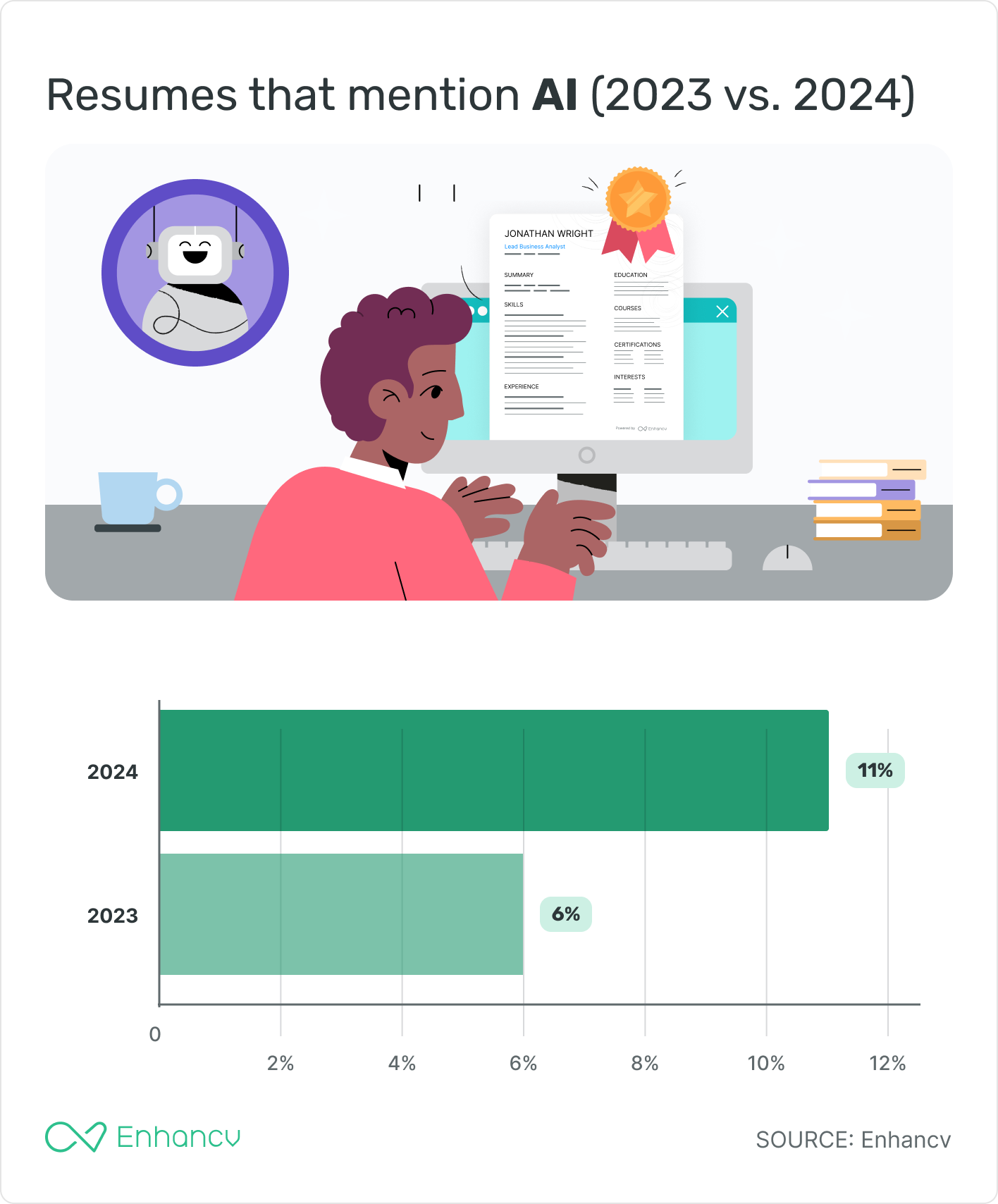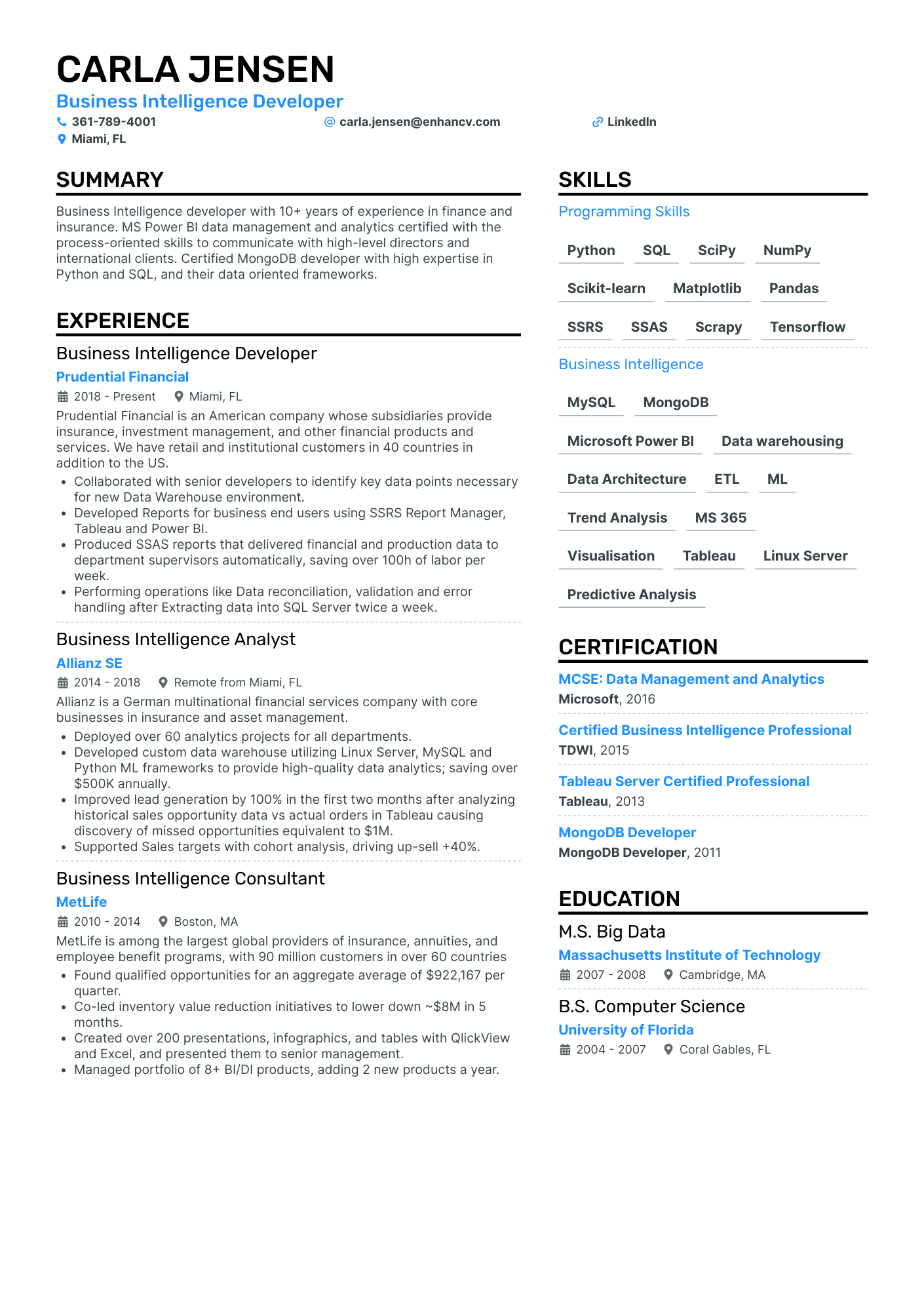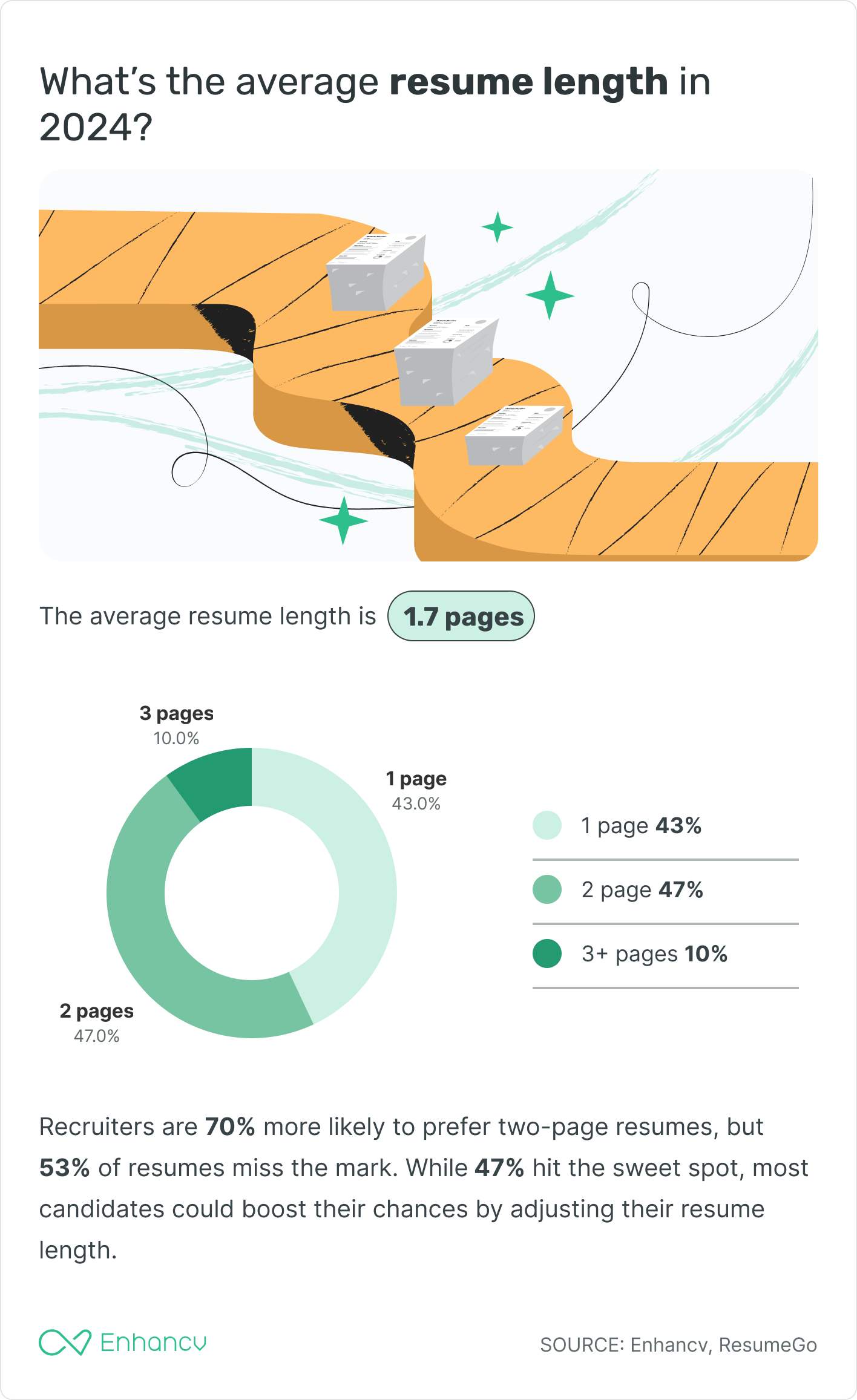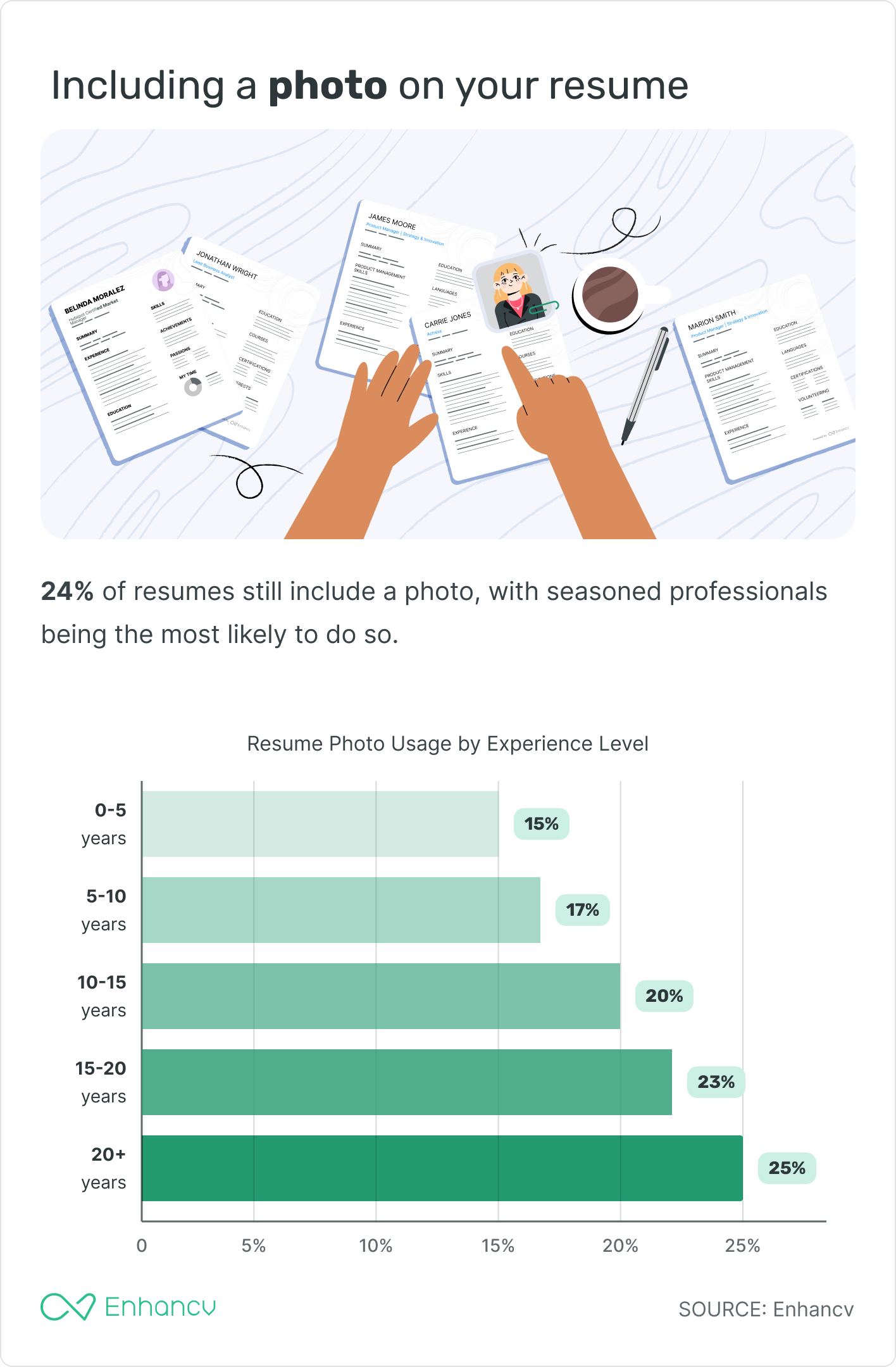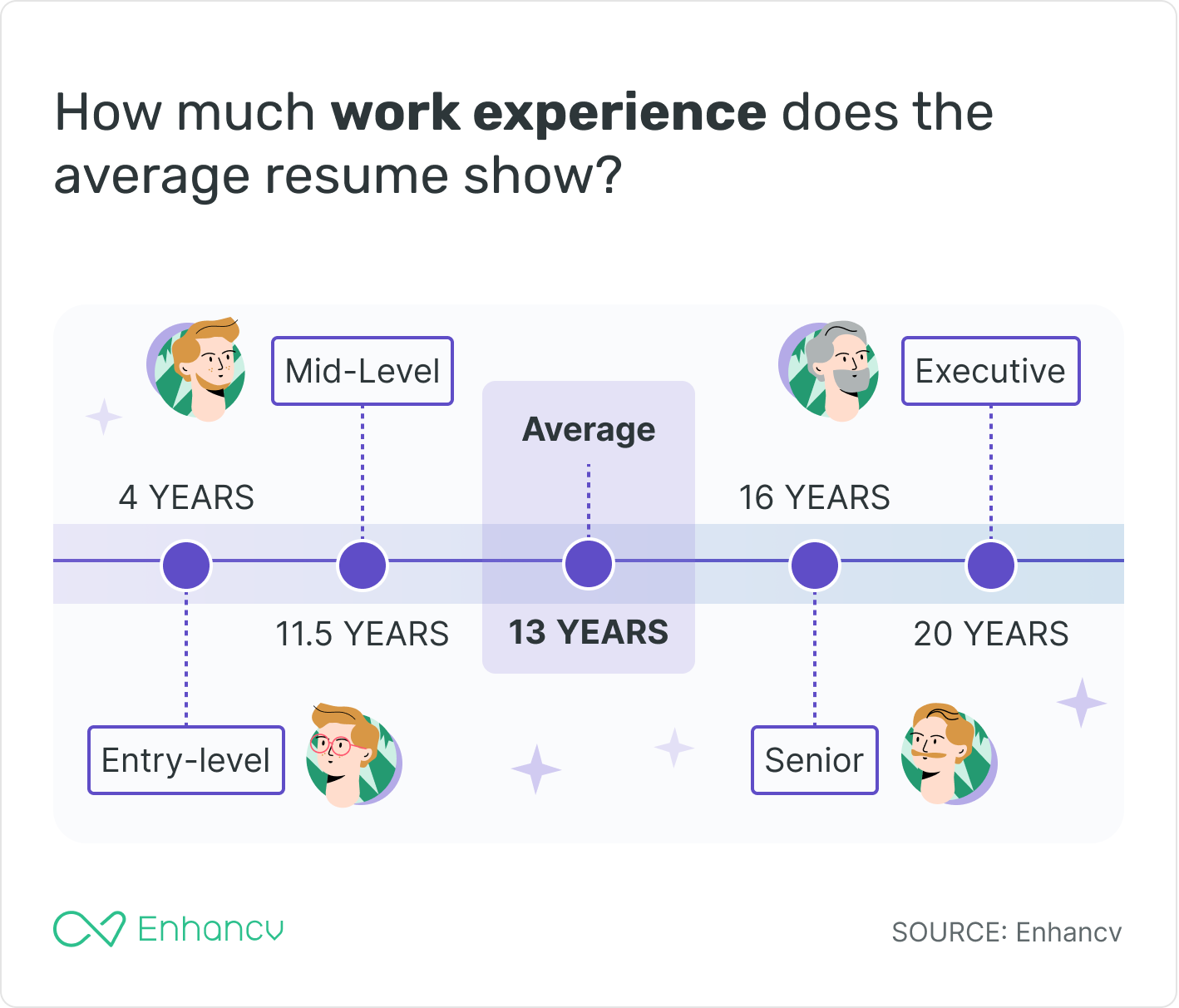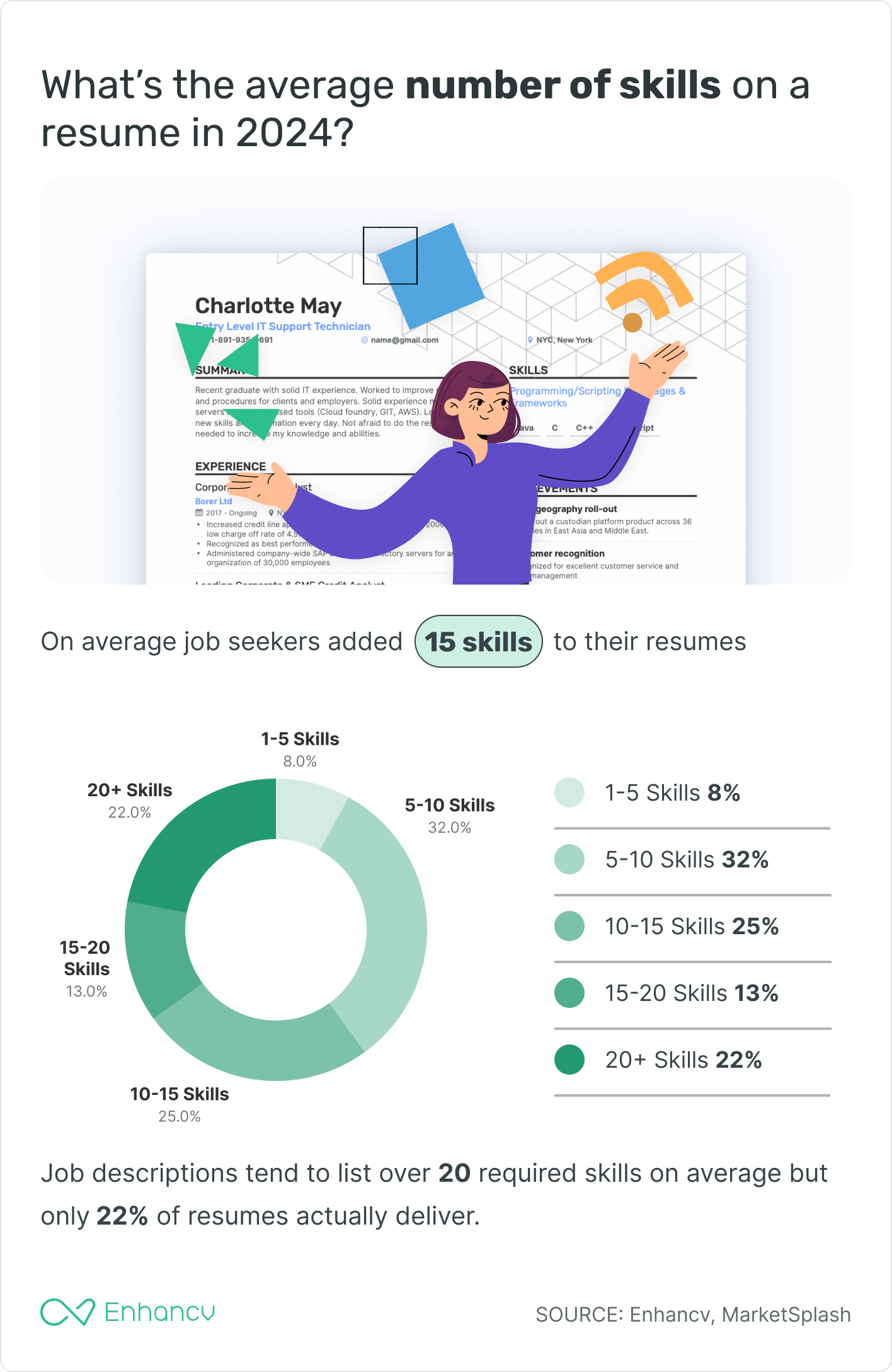As we head into 2026, job seekers face an ever-evolving job market where a good resume can make or break their chances. Our analysis of 31,000 resumes uncovers the freshest trends and game-changing strategies. It also gives some eye-opening insights that challenge industry norms—backed by compelling statistics.
Read on to see what’s really shaping resumes in 2026 and how you can build one that stands out from the crowd.
The average resume by the numbers
- 2024 resume snapshot:The average resume contains 1.7 pages, 683 words, 15 skills, 13 years of experience, and 5 jobs.
- Gender gap in AI adoption: Men are still over twice as likely to mention AI on their resume compared to women, revealing a persistent divide in tech skill representation.
- Double-column resumes rule: 96% of job seekers in 2024 chose a double-column format, diverging from expert advice that favors the simplicity of single-column layouts.
- Experience inflates resumes: Two-page resumes now average 62% more words than one-pagers, reflecting a trend where job seekers feel pressured to prove their worth through sheer volume.
- Remote roles, bigger stories: Just 35% of remote workers stick to one-page resumes, compared to 45% of office-based employees. Flexible work leads to more expansive career narratives.
- Skills surge noted: A noticeable trend in 2024 is job seekers listing an average of 15 skills, especially in AI and strategic planning—a sharp increase from last year.
- Photos are risky business: Despite fears of discrimination, candidates in tech, healthcare, and education still gamble on including photos in their resumes.
- Numbers win interviews: Including quantifiable achievements can boost interview chances by up to 40%, yet only 8% of job titles in resumes feature metrics.
- Tech meets touch: Even amid a tech boom, soft skills remain invaluable, with 91% of recruiters seeking qualities like leadership and analytical skills in candidates.
- Professionalism pays off: Surprisingly, 76% of resumes are passed over due to unprofessional email addresses, emphasizing the importance of sweating the small stuff.
- Redefining the black tie: In 2024, 75% of job seekers used color on their resume instead of the industry classics—black, and blue.
- Customizing to conquer: Tailoring resumes to fit specific job descriptions is proving successful, with 83% of recruiters showing a preference for such personalized applications.
Let’s break down the resume trends and stats shaping how candidates are landing opportunities in 2024 and beyond.
Resume writing trends and key statistics
We’ve given you the big picture—now it’s time to zoom in.
Overview of general resume trends
- There are 250 applicants for every job posting at the corporate level (Glassdoor).
- 60% of job applications are abandoned because they take too long to complete (TeamStage).
- Competition for graduate-level positions is increasing, employers received an average of 140 applications per role in 2023-24, a 59% year-on-year increase (The Times).
- Job descriptions containing 201-400 words have the highest application rates, ranging from 8% to 8.5%, while those under 200 words have rates of around 4.5% (Withe).
- Less than 3% of resumes sent get a job interview (Team Stage).
- 83% of recruiters confirm they’re more likely to hire candidates who’ve tailored their resume to the specific job they're applying for (Jobvite).
- 50% of jobs at the senior and executive level aren’t advertised (CJPI).
On average it takes 5 months to find a job in the US (SWNS Digital). However, 68% of candidates who use a professional resume-writing service get a job within 90 days (The Motley Fool).
The rise of AI in resume writing
AI is reshaping the world of resumes, from how candidates write them to how companies review them. Mentions of AI skills are rising, AI tools are helping craft applications, and hiring managers are increasingly open to this shift.
But beneath the buzz, there are trends worth a closer look.
- Mentions of AI in resumes have nearly doubled, rising from 6% in 2023 to 11% in 2024 (Enhancv).
- 31% of resume builder users wrote their resume with AI in 2024 (Enhancv).
- Candidates who mentioned AI on their resume in 2024 had an average of 14 years of experience (Enhancv).
- AI mentions were most common in the tech sector, appearing on 23% of resumes, followed by marketing at 14% and finance at 8% (Enhancv).
- Men are more likely to use AI to write their resume. In 2024 61% of men used AI to write their resume compared to 45% of women (Enhancv).
- Longer resumes - with three pages or more - are more likely to mention AI. This amounts to 17% of all resumes.
- Popular AI-based resume screening tools favor white, male candidates, with resumes featuring white-associated names being selected 85% of the time (University of Washington).
- In 2026, 83% of companies plan to use AI for reviewing resumes (Resume Builder).
- 90% of hiring managers say it’s acceptable to use generative AI in application materials (Canva).
- AI hiring continues to rise, with nearly 331,000 active job postings in 2024, reflecting a 71% year-over-year increase (Computerworld).
Speaking of hiring, the journey doesn’t end with AI-crafted resumes. Getting past the gatekeepers—both human and digital—is still a challenge.
ATS and resume screening
- 70% of large organizations and 75% of recruiters use ATS for resume storage and management (Select Software Reviews).
- 88% of employers believe ATS systems are screening out highly qualified candidates due to resumes that lack ATS-friendly formatting or keywords (Select Software Reviews).
- 25% of organizations are planning to implement an AI-driven ATS by 2027 (Select Software Reviews).
- Single-column and double-column resumes perform nearly identically with ATS parsing, with only a 4% difference in average scores—proof that both formats work when properly optimized (Enhancv).
While ATS plays a significant role in filtering resumes, it’s ultimately recruiters who make the final call.
Recruiters’ resume preferences statistics
- 88% of hiring managers say that work experience is the most important resume section (CareerBuilder).
- 75% of hiring managers want to see quantifiable achievements in a resume’s work experience section (LinkedIn).
- Your resume needs to make a quick impression, but hiring managers don’t take seven seconds to scan a resume. The reality is closer to 17 (CareerBuilder, LinkedIn).
- 61% of hiring managers say a tailored resume is the best way for candidates to improve their chances of getting a job (Zippia).
- 63% of employers prefer to receive resumes and cover letters customized for the specific role (Glassdoor).
- 83% of recruiters say they're more likely to hire candidates with a well-formatted resume (Jobvite).
- 68% of hiring managers would reject candidates with a poorly formatted resume (Jobvite).
- Nearly 80% of recruiters will reject a resume with typos or grammar mistakes. Proofreading pays off (The Motley Fool).
- 73% of hiring managers prefer candidates with a visually appealing resume. And job seekers are meeting their expectations, with 75% choosing vibrant color palettes instead of the default black and blue (Jobvite, Enhancv).
- 76% of resumes are ignored if the applicant's email address is deemed unprofessional. This includes using a work-related email address, but 13% of candidates still used their company email in 2024 (MarketSplash, Enhancv).
- 19% of resumes include a hobbies and interests section, despite 79% of recruiters stating that they don’t read them. Only include hobbies and interests if they’re highly relevant to the role or illustrate unique skills that add value (Enhancv, StandOut CV).
- 91% of recruiters value soft skills on resumes (Finances Online).
- More than 40% of recruiters reported that applicants lacked the necessary soft skills (Team Stage).
- Hard skills are essential too—88% of hiring managers focus on them when reading resumes (Glassdoor).
Resume demographics statistics
Men dominate the resume creation process. In 2024, 58% of resumes were created by men vs. 42% by women—virtually unchanged from 2023 (Enhancv).
- 50% of resumes created in 2024 had 5 to 15 years of experience. Mid-level professionals dominated (Enhancv).
- 14% of resumes from 2024 were from job seekers with up to 5 years of experience, highlighting a smaller proportion of Gen Z or entry-level candidates (Enhancv).
- 64% of resumes created in 2024 included a university-level degree, based on the presence of keywords such as Bachelor’s, Master’s, or PhD (Enhancv).
- In 2024, tech sector workers were the most likely to create a resume at 46% of resumes written, a drop from 53% in 2023 (Enhancv) .
- Data on resume-creation activity among urban and rural job seekers is limited, but urban populations tend to have better internet access, facilitating the use of digital tools for resume creation (Rural Opportunity).
Resume format statistics and trends
While industry experts favor tried-and-true resume layouts, job seekers are embracing double-column templates and contemporary fonts to stand out.
- 96% of job seekers in 2024 prefer a double-column resume, up from 91% in 2023 (Enhancv).
- The Professional Association of Résumé Writers & Career Coaches suggests that a reverse-chronological, single-column layout is most effective (PARWCC).
- Enhancv’s most popular choice in 2024 is the “Double-Column” template, used for 30% of resumes generated this year.
- There's been a decline in Times New Roman and Arial as resume fonts due to overuse (Forbes). Instead, fonts like Calibri, Lato, and Helvetica are now the most popular choices for their modern and professional appearance (Enhancv).
Resume length statistics
Our data highlights an evolving approach to resume length. Early-career professionals aim to prove their value through more detail, while seasoned candidates prioritize delivering a sharper, more targeted narrative.
- The average resume length for 2024 was 1.7 pages—unchanged from 2023. So a two-page resume remains the norm (Enhancv).
- In 2024, the shift towards longer resumes continued, reflecting changing norms in job applications. One-page resumes made up 43% of submissions (down from 47% in 2023), while two-page resumes rose to 47% (up from 43%). The proportion of three-page or longer resumes held steady at 10% (Enhancv).
- In 2024, resumes created with Enhancv's resume builder averaged 473 words for one-page resumes and 765 words for two-page resumes, reflecting the need for more space as experience levels grow (Enhancv).
- Job seekers in 2024 with one-page resumes had an average of 11 years of experience. Candidates with two-page resumes had an average of 15 years, and those with three or more pages clocked in at 18 years—no notable changes from 2023 (Enhancv).
- Remote workers are less likely to have a one-page resume. 35% wrote a one-pager vs 45% who work in traditional salaried roles (Enhancv).
- Retail and real estate workers leaned towards one-page resumes, 52% and 53% of job seekers in those fields respectively (Enhancv).
- Marketing and education sector candidates preferred two-page resumes, 50% and 54% of workers in each field (Enhancv).
- Education and technology sector job seekers preferred three or more pages, 13% and 12% of candidates in each industry (Enhancv).
- Executive-level resumes are longer than average. 55% have two-page resumes vs 44% for non-executive roles (Enhancv).
- Candidates with an Ivy League education had longer than average resumes at 1.8 pages (Enhancv).
Essential resume length stats
| 1 page | 2 pages | 2+ pages |
|---|---|---|
| Retail (52%) and real estate (53%) | Marketing (50%) and education (54%) | Education (13%) and technology (12%) |
| 11 years of experience | 15 years of experience | 18 years of experience |
| 490 words (junior level) | 610 words (mid-level) | 723 words (senior level) |
| Remote workers: 35% use 1 page | Executives: 55% use 2 pages | Ivy League graduates: average 1.8 pages |
However, resume length is largely determined by experience level. As candidates advance in their careers, their resumes expand to reflect their growing expertise and achievements.
Resume length is determined by experience
- Junior and mid-level candidates are adding more detail to their resumes, with word counts rising slightly to 490 words and 610 words respectively in 2024. This suggests that early-career professionals are emphasizing additional skills, projects, or accomplishments to stand out in competitive markets.
- In contrast, senior-level candidates streamlined their resumes, with word counts dropping from 741 words in 2023 to 723 words in 2024. This points to a focus on concise, high-impact achievements rather than lengthy career histories, reflecting the need for clarity and brevity when showcasing extensive experience.
Resume header facts
The resume header is prime real estate for your professional identity. What candidates choose to showcase there—whether it’s social media links or professional portfolios—reveals how they want to be seen and reached.
- Recruiters access links in a resume header first due to the recency effect, which prioritizes the most immediately visible information. Placing links like LinkedIn profiles or portfolios in the header ensures recruiters can quickly find key details within seconds (Enhancv).
- While professional profiles are common, 27% of resumes included no links at all. Only 2% featured a personal website, and just 0.6% linked to code repositories, showing many candidates missed opportunities to showcase their unique skills and projects (Enhancv).
- LinkedIn remains the primary social media platform listed on resume headers—no surprise given that 72% of recruiters use LinkedIn for hiring (The Social Shepherd).
- In the U.S., EEOC guidelines discourage employers from requesting photos, as this can lead to discrimination.
Interestingly, our users seem to buck this trend. While the stats suggest photos on resumes lead to rejection, many still choose to include them—a divergence that highlights the personal branding preferences of modern job seekers.
- Technology, healthcare, and education candidates are the most likely to include photos on their resumes (Enhancv).
- Candidates with 15 years of experience are more likely to include a resume photo, compared to 13 years for those who opt out (Enhancv).
- 24% of resumes include a photo, with seasoned professionals being the most likely to do so (Enhancv).
- Sectors such as modeling and acting often require photos, as appearance is integral to the role. Data for modeling and acting resumes was limited, but of the resumes positively identified as belonging to actors, 55% included a photo (Enhancv).
Job seekers often risk breaking industry norms, whether by adding photos in fields where they're discouraged from doing so or listing emails that compromise confidentiality.
- Company email addresses remain a go-to choice for professionals with 15+ years of experience, suggesting that as careers advance, job seekers are more likely to leverage their company affiliation to boost credibility on their resumes (Enhancv).
But:
Including a business email address on your resume is generally discouraged due to confidentiality concerns and potential legal boundaries.
Resume summary statistics
The boundaries between resume summaries and objectives are blurring. In 2024, who you are is just as important as what you’ve done.
- Nearly 89% of resumes included a summary section, emphasizing its importance as a key feature for making a strong first impression (Enhancv).
- Searches for “personal branding resume” are rising in 2024, with related topics focusing on skills and career goals. This trend signals a shift in how job seekers approach summary statements, emphasizing individual identity and value over generic descriptions (Enhancv).
- Resume summaries are getting more wordy. There were an average of 74 words in a resume summary in 2024 compared to 67 words in 2023 (Enhancv).
- Resume summaries grow longer with experience. Junior professionals average 55 words, mid-level 63, and those in senior roles 73. Tailor your summary to reflect your career stage, keep it concise for entry-level roles, and weave in key accomplishments as you advance (Enhancv).
Work experience section trends in US resumes
As career paths become more dynamic, the number of positions listed on resumes reflects this shift. From junior professionals to C-level executives, job transitions are shaping the narrative of work experience more than ever.
Number of positions listed
- In 2024 the average resume listed 5 jobs, unchanged from 2023 (Enhancv).
- Resumes with one page list an average of 4 jobs, while two-page resumes include 6, and those with three or more pages feature 9 jobs (Enhancv).
- Career progression is reflected in job transitions. Junior professionals average 4 jobs, mid-level 5, and senior roles 6 (Enhancv).
- The seniority level with the highest average number of jobs is C-level titles (CEO, CFO, COO, CPO), with an average of 10 jobs (Enhancv).
- Public Relations professionals tend to have the most diverse career paths, averaging 20 jobs, while those in aerospace and business have the least, with an average of just 4 (Enhancv).
Longest-held positions and overall experience length
- The average resume in 2023 featured 12 years of experience. In 2024 this number rose to 13 years. A clear trend for more experienced candidates updating their resumes (Enhancv).
- On average, entry-level candidates have 4 years of experience. Mid-level applicants typically have 11.5 years, senior professionals 16 years, and executives 20 years (Enhancv).
- Professionals in education, real estate, and manufacturing boast the most experience, averaging nearly 15 years. Those in technology and healthcare average slightly less at around 13 years (Enhancv).
- The longest-held role we uncovered was 48 years. The resume creator had been with the same employer since 1976 (Enhancv).
Remote and hybrid working
23% of resumes in 2024 mentioned remote work, a slight drop from 2023 when 24% included remote work.
Men are more likely to pursue remote work opportunities. In fact, 54% of remote-focused resumes come from men compared to 46% from women (Enhancv).
- 27% of employees currently work remotely or in hybrid mode (Backlinko).
- 53% of US workers reported working in a hybrid model, reflecting a steady rise in flexible work arrangements (Statista).
- 75% of workers are willing to relocate for a job, the other 25% would quit if asked to relocate. The most preventative factor for relocation is the cost of living (Monster Poll).
- Boston and Portland are the cities where job seekers are most likely to change jobs after relocating, with around 14% making a career switch. This trend reflects the strong industry growth attracting talent to these regions (Bank of America).
- Following the 2024 presidential election, Google searches about moving abroad surged by 1.5%, with countries like Norway, the UK, Ireland, and Costa Rica drawing the most interest (VisaGuide.World).
- Similarly, pages related to Germany’s Opportunity Card saw a 336% increase in traffic, reflecting heightened interest among Americans in relocating internationally (Germany-Visa.org).
- Searches about how to move to Canada grew over 3000% in the immediate aftermath of the US presidential election in 2024. However, they fell back to previous levels by the end of November, making it a short-term but notable surge (Google Trends).
Freelancer resume statistics
- Approximately 36% of the U.S. workforce engages in freelance work, emphasizing the growing significance of freelancing in today's job market (Zippia).
- Among freelancer resumes created in 2024, 57% were from male candidates, while 43% were from female candidates (Enhancv).
- Freelancers highlighted more experience on their resumes. 15 years of experience for freelance roles compared to 13 years for traditional salaried roles (Enhancv).
Using quantifiable achievements
Quantifiable achievements are the resume staple we keep ignoring—and it’s costing candidates opportunities. In a job market increasingly driven by data, numbers are the proof points that set resumes apart. Yet, many job seekers still miss this chance to showcase measurable impact, despite the clear advantages.
- Including numbers on your resume can increase your chances of landing an interview by as much as 40% (Fast Company).
- Despite this, only 8% of resume job titles contain measurable details, like percentages or dollar amounts (Enhancv).
- Performance-focused fields like retail lead the way, with 24% of job seekers including metrics in their headers. In education, that number drops dramatically to just 4% (Enhancv).
The header on your resume is a prime spot to highlight your top achievements, but be careful—it's easy to clutter with all sorts of random info.
Skills section statistics
The average resume lists 15 skills in 2024, an increase from 13 in 2023 (Enhancv).
Here’s a detailed breakdown for 2024:
- 8% listed 1 to 5 skills
- 32% featured 5 to 10 skills
- 25% contained 10 to 15 skills
- 13% included 15 to 20 skills
- 22% listed 20+ skills
Additional insights into resume skills trends include:
- Professionals in technology and marketing tend to highlight a wide range of abilities, averaging 18 and 14 skills respectively. In contrast, those in retail and education focus on fewer, averaging around 9 skills each (Enhancv).
- The record for the most skills listed on a resume is 232, held by a software engineer with 12 years of experience (Enhancv).
- Men tend to list more skills on their resumes than women, with an average of 15 compared to 13 for women (Enhancv).
Top 10 skills for 2023 and 2024 (all industries)
Keeping track of the most sought-after skills each year offers key insights for job seekers and employers alike.
Here are the top 10 resume skills for 2023 and 2024, highlighting shifts towards both technical skills and leadership capabilities.
Top Skills in 2023 vs. 2024
| YEAR | TOP SKILLS |
|---|---|
| 2023 | Python, Project Management, SQL, Jira, Leadership, Excel, Communication, Agile, Microsoft Office, Tableau |
| 2024 | Project Management, Strategic Planning, Excel, Python, Microsoft Office, SQL, Jira, Salesforce, Leadership, Team Leadership |
Key Trends
- Strategic planning has seen a remarkable rise in popularity, leaping from being the 16th most popular skill in 2023 to the number two spot in 2024. This highlights its increasing value among job seekers (Enhancv).
- Hard skills like project management, Python, Excel, SQL, Jira, and Microsoft Office appear on both lists. These remain must-haves for professionals, reinforcing their importance across industries (Enhancv).
- Salesforce enters the 2024 list, highlighting the increasing demand for CRM proficiency as businesses prioritize client management and sales processes (Enhancv).
- In 2023, communication topped the list of soft skills. However, by 2024, it’s considered a baseline expectation rather than a standout skill. Leadership remains a key skill, with team leadership emerging as a focus, suggesting a shift from general interpersonal abilities to more structured and team-oriented leadership roles (Enhancv).
Takeaways
- Stay current: Invest in skills that remain consistent year-over-year, such as project management, Python, and Excel.
- Develop leadership abilities: Focus on growing your team leadership and strategic planning skills, which are increasingly valued.
- Adapt to industry needs: If working in sales, marketing, or client-facing roles, gaining Salesforce expertise could give you an edge in 2026.
- Keep technical skills relevant: Maintain proficiency in key technical tools like SQL and Jira, as they continue to be in demand.
Skill-based hiring is the #1 hiring method
As the workforce evolves, skill-based hiring is becoming a cornerstone of modern recruitment strategies.
Here’s a closer look at how employers and candidates adapt to this trend in 2024:
- 81% of employers adopt skills-based hiring methods (TestGorilla).
- 94% believe assessing skills is a more reliable indicator of job performance than reviewing resumes (TestGorilla).
- 88% find that employees hired for their skills stay longer in their jobs (TestGorilla).
- 98% say skills-based hiring is more effective at finding talented candidates than resumes (TestGorilla).
- Employees also favor skills-based hiring. In fact, 68% of candidates worldwide prefer it (TestGorilla).
Skills recruiters prioritize
With the job market's increasing complexity, certain skills stand out as particularly valuable to recruiters looking to future-proof their teams.
Here are the skills that are currently in high demand:
Proficiency in ChatGPT became one of the fastest-growing resume skills in 2024, with mentions soaring 274% compared to 2023. This rapid growth highlights the increasing demand for AI expertise in the job market (Enhancv).
- 75% of commercial enterprise applications will integrate AI by 2026, enhancing HR and talent acquisition (Gartner).
- 80% of middle-skill jobs now demand digital literacy, establishing it as a standard across many roles (Burning Glass Technologies).
- 89% of employers now value soft skills more than they did five years ago, indicating a significant shift towards interpersonal abilities (TestGorilla).
- 50% of all employees will require reskilling by 2026, particularly in technology-related fields (The World Economic Forum's Future of Jobs Report).
- 80% of employers are ready to engage in creating new apprenticeship programs, highlighting the importance of collaborative skill development (American Association of Community Colleges).
Hybrid work skills
The current trends indicate a growing need for hybrid work skills into 2026 as more employers and employees embrace flexible working arrangements. This shift highlights the increasing importance of skills for managing remote and hybrid environments effectively.
- A notable 98% of employees favor remote work at least part-time, highlighting the general preference for flexible working arrangements (RemotePad.com).
- The workforce is diversely distributed with 14% fully remote, 57% in-office, and 29% in hybrid roles, reflecting a range of work preferences (WorkWellRemote).
- 60% of U.S. job seekers prefer hybrid roles, indicating a strong preference for combining remote and onsite work (Robert Half).
- There’s been a decrease in new fully in-office job postings, dropping to between 64% and 66%, showing a shift towards more flexible work options (Robert Half).
- By 2028, 73% of all departments are expected to have remote workers, signaling an ongoing shift towards telecommuting (Findstack.com).
Education section trends
In 2024, trends show a growing emphasis on academic performance, internships, and the evolving relationship between education and career choices.
- Academic roles make up 11% of all resumes, highlighting the niche yet significant demand for education and research-focused careers (Enhancv).
- 50% of resumes include a Bachelor's, Master's, or PhD (Enhancv).
- Completing an internship makes you 85% more likely to secure a full-time job once you graduate (Standout CV).
- Employers’ use of GPA as a screening tool for new college graduates has risen to 38.3%, reflecting increased emphasis on academic performance in hiring decisions (NACE).
- In the 2023-24 academic year, U.S. higher education institutions received over 1.8 million applications to the most selective schools, admitting less than 25% of applicants (NACE).
- 74% of employers offer job positions to interns immediately after their internship ends, making internships a critical pathway to employment (Student Times).
- 40% of resumes don’t have education and work experience aligned, proof that career paths often diverge from academic beginnings (Enhancv).
Cover letter statistics
You might think cover letters are outdated, but in fact, the role of a well-crafted one, alongside a resume, cannot be overstated.
Here’s how vital cover letters are in the recruitment process:
- 74% of recruitment decision-makers prefer job applications that include cover letters. They see them as a valuable addition to resumes (Human Resources Online).
- About 53% of employers believe a resume alone isn’t enough to stand out. Also, 49% of HR managers say a cover letter significantly improves a resume’s noticeability, second only to tailoring the resume for the specific job (CareerBuilder).
- 45% of recruiters might reject a resume that doesn’t come with a cover letter, showing its critical role in job applications (CareerBuilder).
Linkedin on a resume: the key statistics
In today's digital-first job market, LinkedIn, as a predominant player, has reshaped how hiring managers discover and vet candidates.
Here's a closer look at some compelling statistics that demonstrate the importance of integrating LinkedIn into your resume:
- 33% of resumes in 2024 were missing a LinkedIn profile in the resume summary, down from 36% in 2023 (Enhancv).
- 94% of recruiters use LinkedIn to vet candidates. This means 1 in 3 candidates are missing a vital optimization opportunity (Zippia).
PRO TIP
Make sure to update your LinkedIn profile in tandem with your resume to maximize your visibility and not miss any job opportunities.
- In 2024, 81% of technology sector workers included LinkedIn profiles in their resume summary, making them the most likely group to do so. In contrast, education industry professionals were the least likely, at 52% (Enhancv).
- Approximately 71% of recruiters have rejected a candidate because of their LinkedIn profile picture, even if the candidate's qualifications were appropriate. Furthermore, nearly 38% of recruiters do this regularly (passport-photo.online).
Fun facts and unique insights
Let’s explore some fun facts and eye-opening insights that show just how crucial—and interesting—your resume can be when chasing that dream job.
Extreme resumes
Some job seekers go to great lengths—literally!—to detail their extensive experience.
Let’s see the most exceptional cases:
- The longest resume had 12 pages and 4256 words. It belonged to a candidate with 26 years of experience in the tech sector and listed 23 jobs (Enhancv).
- One notable resume presented 232 skills. It featured 12 years of experience and 11 years of education on a nine-page resume with 3253 words (Enhancv).
Use of action verbs in resumes
Ready to give your resume a competitive edge?
The right choice of words can significantly boost your interview prospects:
- Utilizing action verbs can boost your chances of landing an interview by up to 140% (Finances Online).
- "Managed," "led," and "developed" are the action verbs most frequently seen, each appearing in over 60% of resumes (Enhancv).
- The adjectives "new," "strategic," and "high" appear in 68%, 58%, and 54% of resumes respectively, enhancing descriptions with a touch of freshness, foresight, and elevation (Enhancv).
- Dominating the superlative game, "best," "largest," and "highest" are used in 27%, 8%, and 7% of resumes to underscore achievements and excellence (Enhancv).
- In terms of gender-coded language, "leadership," "leading," and "analysis" appear in 60%, 50%, and 48% of resumes, typically reflecting masculine-coded words.
- Meanwhile, "support," "collaboration," and "collaborated" are seen in 56%, 41%, and 35% of resumes, indicating feminine-coded terminology (Enhancv).
Unprofessional email addresses
Remember, the devil is in the details when applying for your dream job. While your resume might be top-notch, don't let something as simple as your email address rob you of opportunities.
- A striking 76% of resumes are rejected due to unprofessional email addresses, underlining the importance of a professional contact detail (TeamStage).
Here’s an example that might give us a chuckle, but unfortunately, it’s not so funny for the applicant involved.
- Slang changes can turn a harmless email into an unfortunate choice due to evolving language:
Sometimes, your name is just unfortunate for an email. So you have to work around it. Like this instance: Email address was probably fine 15 years ago, but slang changes. first/middle initials AF, last name Loving, address is LovingAF@ - tmgieger
5 most unusual resume skills
Some candidates go the extra mile to stand out with truly unique talents.
Here are some unconventional skills that could surprisingly snag you your next job opportunity:
- TikTok: Ideal for a social media specialist role at a forward-thinking marketing agency.
- Shucking oysters: Perfect for a position as a specialty chef at a high-end seafood restaurant or oyster bar.
- Martial arts: Could be the knockout skill needed for a stunt coordinator in film production or a personal trainer specializing in self-defense.
- Basketball fundamentals: A slam dunk for coaching positions or a sports analyst focused on basketball techniques.
- Walking on the beach: Might just be what a tour guide in a scenic coastal town needs to add charm to their tours.
Most trusted sources of career advice
Not all sources are created equal. From trusted mentors to trending platforms, where you turn for guidance can shape your professional journey—or send you down the wrong path.
- College career counselors are regarded as the most credible source for professional advice, with 77% of job seekers trusting their guidance. Family and bosses were the second and third most trusted sources of career advice, held in high regard by 70% and 63% of candidates respectively (Enhancv).
- The biggest mistrust in career guidance goes to AI and influencers: 20% of job seekers doubt ChatGPT, while 17% mistrust social media influencers. TikTok (9%), Instagram (11%), and Facebook (12%) follow as the least trusted sources for job advice (Enhancv).
- However, 25% of Gen Z trust TikTok for career advice—double the rate of millennials—underscoring a growing generational divide in trusted career guidance (Enhancv).
Uk cvs vs. US resumes: major trends
Depending on where you’re located, it’s crucial to know the differences between a CV and a resume. Whether it’s adding a photo or detailing your education, these seemingly small details can make a big difference in catching the eye of HR.
Let’s dive into some of the major trends and regional quirks that could help you tailor your resume accordingly:
- In the EU, CVs typically include a photo—67% of resumes without one are overlooked by HR.
- The UK stands as an exception, largely due to its anti-discrimination laws. Sources indicate an 88% job rejection rate for CVs featuring a photo. Note: the data may not be up-to-date.
- Resumes being more concise in general tend to include shorter education sections, while a more detailed approach is acceptable with UK employers.
Resume predictions for 2026
Looking ahead to 2026, the way we search for jobs and how employers find us is changing fast.
Here's a peek at how social media and new resume formats are set to shake things up in the job market:
- 67% of employers use social media to screen candidates (Fit Small Business). By 2026, personal branding will replace generic objective statements with consistency across your resume, LinkedIn, and other social platforms becoming critical, as employers seek candidates whose digital identity reflects a strong, authentic brand.
- Despite the growing role of social media in personal branding, less than 1% of resumes included Instagram, Facebook, Twitter, or TikTok links (Enhancv).
- As digital-native generations enter the workforce, TikTok resumes are expected to boom, becoming a popular hiring medium (New York Post). Video resumes are set to grow with 79% of hiring managers valuing video for vetting candidates (BBC) and 61% of job seekers viewing it as the future of cover letters (LinkedIn).
- Pronouns are absent from 99% of resumes, reflecting a widespread effort to avoid bias sparked by names or photos. But as diversity and inclusion remain front and center, 2026 may see more candidates embracing pronouns to assert their identity (Enhancv).
Research methodology
In addition to the external research cited, Enhancv statistics are drawn from an internal analysis of 31,000 resume builder users from the years 2023 and 2024.
Users were randomly chosen to ensure representation across demographics such as age, gender, and industry. The data was collected through user inputs, focusing on metrics like resume sections and professional skills.
This information, while insightful, is limited to users of our platform and may not be representative of all job seekers. All data was analyzed in compliance with privacy laws, with personal identifiers removed to maintain confidentiality.
Make one that's truly you.





